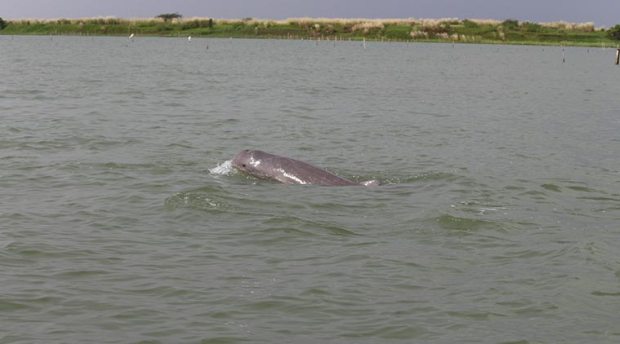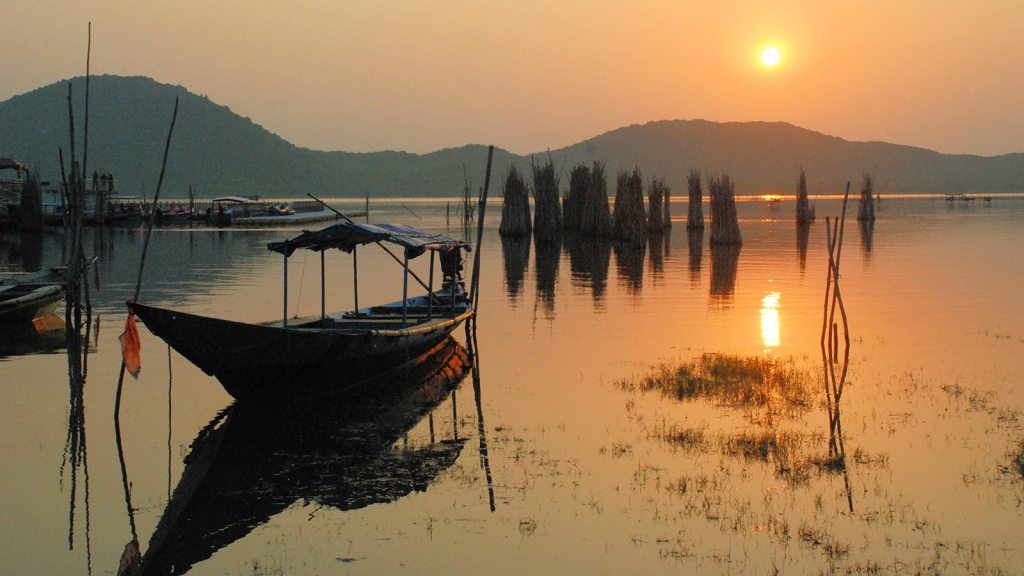Chilika Lake, a UNESCO World Heritage candidate and designated Ramsar site, is not just a lake but a dynamic ecosystem that attracts hundreds of thousands of migratory birds every winter. It’s a must-visit destination for bird enthusiasts, nature lovers, and photographers alike.
Chilika Lake: A Rich Habitat
The unique ecology of Chilika Lake is driven by its blend of saltwater from the Bay of Bengal and fresh water from nearby rivers, creating a nutrient-rich environment ideal for various species. This environment supports more than 200 bird species, with migratory birds flocking here from as far as Siberia, Mongolia, the Himalayas, and other regions. The peak season for birding is between November and February when the lake transforms into a vibrant hub of avian activity.
Species to Look Out For
Among the lake’s avian residents, several iconic species make Chilika particularly special for birdwatchers:
- Greater Flamingos: One of the main attractions, these striking pink birds can often be seen gracefully moving through the shallow waters, adding a splash of color to the lake’s landscape.
- Peregrine Falcons: Known as one of the fastest birds of prey, the peregrine falcon is a thrilling sight for birders lucky enough to spot one as it swoops down on its prey.
- White-Bellied Sea Eagles: These impressive raptors are frequently seen soaring above the lake, diving down for fish and other aquatic prey, adding an element of excitement for bird watchers.
- Bar-Headed Geese: These hardy migratory geese undertake one of the longest migrations across the Himalayas to reach Chilika, making them a symbol of endurance and resilience in the avian world.
- Common Shelducks, Spot-Billed Pelicans, and Asian Openbill Storks: These are only a few of the many species that populate the lake, bringing both variety and color.
Bird-Watching Spots in Chilika
The lake offers numerous birding hotspots, each providing a unique vantage point to observe different species and behaviors:
- Nalabana Bird Sanctuary: Spread over 15.5 square kilometers, this sanctuary is a haven for migratory birds. With shallow waters and abundant food, it’s the perfect feeding ground for several species, including ducks, geese, and waders. Nalabana is an ideal spot to watch large flocks during the winter.
- Mangalajodi Wetlands: Situated on the lake’s northern shores, Mangalajodi is famous for its dense bird populations, especially waterfowl, shorebirds, and raptors. Managed by local conservation efforts, it offers a serene setting for photographers and birdwatchers.
- Satapada: Located at the southeastern tip of the lake, Satapada offers a chance to witness the coexistence of Irrawaddy dolphins and various waterbirds. It’s also a good starting point for boat rides into the deeper sections of the lake.
- Brahmapura: A relatively quieter area, Brahmapura is an offbeat location that offers an undisturbed view of the lake and its wildlife, perfect for those seeking a secluded bird-watching experience.
Experiencing Chilika: Best Tips for Birdwatchers
- Timing: Plan your visit between November and February to catch the peak migratory season when Chilika’s bird population is at its highest. Early mornings and late afternoons are generally the best times for birding as the lighting is optimal, and bird activity is heightened.
- Guided Boat Tours: Hiring a boat with a knowledgeable guide can enhance the experience, allowing you to access deeper parts of the lake and navigate through marshes to get close to bird flocks without disturbing them.
- Responsible Birding: Since Chilika is an ecologically sensitive zone, it’s essential to follow guidelines to minimize disturbances to the birds. Maintain a respectful distance, avoid making loud noises, and avoid using flash photography.
- Carry Binoculars and Telephoto Lenses: Given the lake’s vastness, having the right equipment can make a big difference in viewing birds from a distance and capturing quality photographs.
- Local Knowledge: Consider hiring a local guide who understands the ecosystem and can point out rare species, hidden birding spots, and interesting ecological facts about the lake.
Conservation Efforts in Chilika
Chilika Lake is under the care of several conservation initiatives led by both government and local communities. The Chilika Development Authority (CDA) has taken steps to prevent siltation, maintain water levels, and manage fishery resources to support the delicate balance of this biodiverse region. Local organizations around Mangalajodi have worked to prevent poaching, leading to a revival in the bird population and fostering sustainable ecotourism practices that protect Chilika’s unique ecosystem.
Birding in Chilika Lake offers a one-of-a-kind opportunity to witness the beauty of India’s birdlife. With its unique blend of freshwater and saline habitats, the lake is an extraordinary example of nature’s biodiversity and serves as an inspiration for conservationists, photographers, and travelers. Whether you’re a seasoned birder or a curious observer, Chilika is a destination that promises unforgettable encounters with nature in its purest form.
Other Activities in Chilika
Aside from bird-watching, Chilika Lake offers several other exciting activities for visitors, catering to a variety of interests. Here are some of the top activities to enjoy at Chilika:

1. Boat Rides
- Dolphin Spotting: Chilika is one of the few places in India where you can spot the rare Irrawaddy dolphins. Satapada, in the southeastern part of the lake, is a prime location for dolphin sightings. Boats can take you on tours specifically designed for dolphin spotting, which is an exciting experience for all ages.
- Island Hopping: Chilika Lake is dotted with several islands, each with its unique charm. Kalijai Island, known for its temple dedicated to the goddess Kalijai, is a popular stop. Bird’s Island, with its rich bird population, and Honeymoon Island, a quiet and picturesque location, are also worth visiting. Boating tours can be customized to include multiple islands.
2. Fishing and Crabbing
- Fishing is a traditional livelihood around Chilika, and visitors can experience it firsthand. You can join local fishers for a unique fishing or crabbing experience, learning about traditional techniques used by the communities. Fresh seafood like prawns, crabs, and fish caught from the lake can also be enjoyed at local eateries.
3. Exploring Mangalajodi’s Wetlands
- For nature lovers and ecotourists, Mangalajodi offers a serene environment to explore the lake’s wetlands. Managed by local communities, Mangalajodi has become a popular eco-tourism destination where you can paddle through reeds and observe a range of flora and fauna. This area’s conservation-based tourism supports the local economy and protects bird populations.
4. Pilgrimage to Kalijai Temple
- Kalijai Island is home to the revered Kalijai Temple, dedicated to Goddess Kalijai, a deity worshipped by locals, especially fishers. The temple holds a special place in the hearts of the people in the region, and visitors come here to seek blessings for safe journeys. The annual Makar Sankranti festival draws a large number of pilgrims, creating a lively atmosphere on the island.
5. Photography and Nature Walks
- Chilika’s vast, scenic landscapes and diverse bird species make it an ideal location for nature photography. Early mornings and late evenings are the best times for capturing beautiful shots of the lake’s wildlife and scenery. Certain areas, like Nalabana and Mangalajodi, are perfect for taking quiet nature walks and appreciating the biodiversity.
6. Camping and Stargazing
- With its quiet islands and limited light pollution, Chilika provides a perfect setting for camping and stargazing. Some tour operators and eco-camps offer overnight stays, allowing visitors to enjoy the tranquility of the lake under a starlit sky. These camping trips often include bonfires and local music, making it a memorable experience.
7. Local Craft Shopping
- Nearby villages and towns around Chilika are known for their crafts, particularly Pattachitra painting and shell crafts. You can visit local markets to purchase these traditional crafts, supporting artisans and taking home unique souvenirs as a memento of your trip.
8. Exploring Regional Cuisine
- Chilika is famous for its unique regional cuisine, which includes fresh lake-caught seafood and local Odia dishes. Try specialties like crab curry, prawns, and fish cooked with local spices. The nearby town of Barkul offers some popular lake-view eateries serving delicious, authentic Odia cuisine.
When to Visit Chilika
The best time to visit Chilika is between November and February when the weather is pleasant, migratory birds are in abundance, and the dolphin-spotting chances are high.
Disclaimer:
This article contains sponsored content that may not reflect the independent opinion or views of FinancialExpress.com. Further, FinancialExpress.com cannot be held responsible for the accuracy of any information presented here. Please consult a certified financial advisor before making any decisions based on this article.


